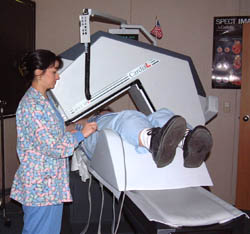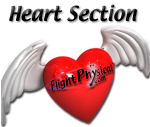FAA Aeromedical Work Up-SPECTMyocardial Perfusion Imaging stress test
|
|
Myocardial Perfusion Imaging stress test which the FAA may require in certain instances. It is usually done in Nuclear Medicine Departments or Cardiac Clinics, your AME will help you arrange this. They may perform the test on an outpatient or inpatient basis. The test involves an injection of a small amount of radioactive material which circulates in the bloodstream and shows if your heart muscle is receiving adequate blood supply under stress and/or rest conditions. The radioactive injection is a clear liquid called MYOVIEW (Tc99m Tetrofosmin for injection). Another material which could also be used is called Thallium. (See product package inserts)
How safe is a Myocardial Perfusion Stress Test?
Any stress procedure may have some risks and you should consult with your physician regarding the risks and benefits of this procedure. The radioactive materials, MYOVIEW and Thallium, have been shown to be safe with low incidence of adverse reactions. This test and materials are used routinely worldwide, under physician supervision, for myocardial perfusion imaging.Neither MYOVIEW nor Thallium are "dyes," and there should be no serious side effects from their injection.
Why would my doctor or the FAA require a Myocardial Perfusion Imaging stress test instead of a regular stress test?
Under certain circumstances, a regular stress test may yield indeterminate results. To improve the diagnostic accuracy, your physician may request a myocardial perfusion stress test.
How is the test performed?
 The test usually consists of two parts, after
exercising and under resting conditions. There are many variations
for performing the test, which depend on the department's routine
procedure. The entire test may be completed in one day or in two
separate days. You will be informed if the exercise or rest portion
will be done first. MYOVIEW will be administered by injection during
peak exercise and once again while you are at rest.
The test usually consists of two parts, after
exercising and under resting conditions. There are many variations
for performing the test, which depend on the department's routine
procedure. The entire test may be completed in one day or in two
separate days. You will be informed if the exercise or rest portion
will be done first. MYOVIEW will be administered by injection during
peak exercise and once again while you are at rest.
As in a regular stress test, ECG electrodes will be attached to your chest. This will allow your physician to monitor your heart rate before, during, and after you have exercised. A blood pressure cuff will be placed on your arm to monitor your blood pressure before, during and after exercise. Additionally, an intravenous (I.V.) line will be placed in your hand or arm vein to allow for ease of the MYOVIEW injection. The IV will be removed when the exam is completed.
The exercise part of the exam is usually done
with a treadmill, very similar to a treadmill used at a healthclub.
Exercising will begin slowly, and approximately every three minutes,
the pace will gradually increase. As you exercise, your heart rate
and blood pressure will change. This is normal and remember you
are being closely monitored throughout the exam. At your peak exercise,
MYOVIEW will be injected into the I.V., and you will be asked to
continue exercising for an additional one or two minutes.
Approximately fifteen minutes after the exercise is complete, pictures will
be taken of your heart using a special camera able to trace either MYOVIEW or
Thallium that has localized in your heart. You will be asked to lie down on
a special table. The camera will rotate above and around your chest while special
pictures are being taken, which will take approximately 20 to 30 minutes to
complete. You may breathe normally while the pictures are being taken. Itis
very important that you hold very still while the camera takes the pictures
of your heart. You will not receive any radiation from the camera.
After one-half hour or so, a second injection of MYOVIEW will be given. The resting pictures are taken in the same manner as the exercise pictures. Remember the order in which pictures are taken depends on the department's routine imaging procedure. The total time needed for the test also varies and may take from two to five hours.
What happens if I am unable to exercise?
Some people, due to a variety of disabilities, are unable to exercise adequately enough on a treadmill machine to achieve a diagnostic test result. In these cases, your physician will decide a course of action for your testing.
Are there any special preparations/instructions for the Myocardial Perfusion Imaging study?
CLOTHING
You should wear comfortable, loose-fitting clothing for exercise and comfortable shoes appropriate for walking.
FOOD
Your physician may instruct you to have a light breakfast and avoid certain foods such as milk products or caffeine-containing beverages. If you are diabetic or insulin-dependent, consult with him/ her on such dietary restrictions and insulin use.
MEDICATIONS
Consult with your physician regarding whether certain medications should
be taken before, or held until after, the test. Certain medications may interfere
with the effectiveness of the exam.
WORK
Depending on the department procedure, time permitting, you may have time
to go back to work between the two parts of the exam. The physician will inform
you if this is possible.
Important Points to Remember
- There may be two parts of the exam. Return for the second part.
- You may receive an injection for both parts of the exam.
- The radioactive material is ordered especially for you. If you are unable to keep your appointment for any reason, notify the department before the exam.
- A written report of the test will be sent to your physician once it is interpreted.
- If you are pregnant or suspect you may be, notify your doctor before taking the test.
Reminder: this information is provided to pilots for educational purposes only. It is not intended to substitute for your AME's medical advice. The user of this site should not use this information to diagnose or treat a health problem or disease without consulting with a qualified health care provider.
Cardiac Problem Index
Overall Problem List
CFR Part 67 Index
Class 1 Standards
Class 2 Standards
Class 3 Standards
Find an AME
Pilot Home
Note: Syncope (fainting), not satisfactorily explained or recurrent requires deferral (even though the syncope episode may be medically explained, an aeromedical certification decision may still be precluded). Syncope may involve cardiovascular, neurological, and psychiatric factors. AMEs will not immediately issue medical certificates if there are heart conditions that require deferral, or for any other cardiac condition that may result in sudden or subtle incapacitation. If the airman has one of these conditions, then the AME will consult with the FAA (AMCD) or the Regional Flight Surgeon. Medical documentation must be submitted for any of these cardiac conditions to support a possible waiver (special issuance) of an airman medical certificate.


